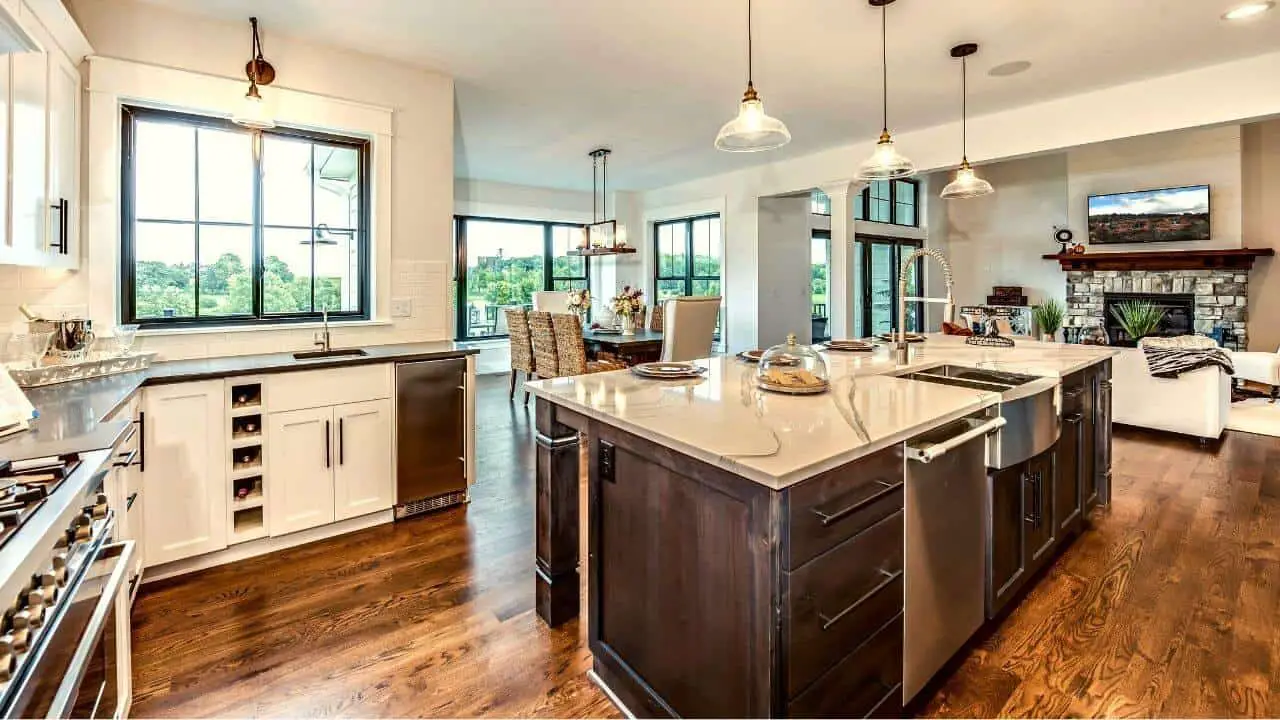Last Updated on May 19, 2023 by River Tree Farms
When doing a kitchen renovation, your kitchen designer may suggest a kitchen island. If your kitchen remodels focus on adding a countertop, a kitchen island is a great addition. A good kitchen island isn’t just beautiful. It gives you extra space too.
Modern kitchens are incomplete without stylish islands. If yours doesn’t have one, you can improvise. Here is how to build a kitchen island with a sink and dishwasher. Let’s know how to build one to upgrade your kitchen.
Things to Consider When Making a Kitchen Island
Although building kitchen islands is pretty easy, certain mistakes could thwart your efforts. So for the best result, your first step should be planning it out. Here are a few things to keep in mind while planning:
Measurement
First thing first, take measurements of your space. Sleek kitchen designs add additional storage with islands.
Determine the area you want to cover and the island size that would look just right. Measure the space above the kitchen counter too if you’re going to build cabinets. Cabinets add functionality to kitchen islands given the storage space.
Keep in mind that you have enough space for:
- bar stool or counter stools
- island cabinets
- prep surface
- travel distance
Kitchen Theme
The next thing you want to decide on is your kitchen theme. Selecting a kitchen theme is important. It helps you in finding out the following:
- Required Materials
- Overall Kitchen Aesthetics
- Budget
- Functionality
- Tools etc.
There is a wide range of aesthetics and themes you can choose from. Such as:
- Modern – Characterized by sleek designs. Also minimalism, open-concept floor plan, and high-end finishes. It has subgenres like:
- Contemporary Kitchen
- Minimalist Kitchen
- Traditional – Features warm colors and natural tone wood floor kitchen. You can take inspiration from- French kitchens, Victorian kitchens, etc.
- Farmhouse – Inspired by rural American homes, has rustic finishes. Farmhouse kitchens are sometimes called country-inspired kitchens. May have stone tile backsplash.
- Industrial -Seen in urban lofts and factories. Accent walls here often feature exposed bricks and ductwork.
- Mediterranean – Showcases the warmth and colors of the Mediterranean region. Special features include:
- granite countertops spaces,
- terra cotta tiles,
- mosaic tile backsplash.
- Alternative – Different from the usual. May have a buzzing electric style, vibrant bohemian style, or, dark gothic style. Many alt kitchens have unique black granite counters and dark wood floors. Bohemian styles have brighter color such as blue island.
Ultimately, the theme you choose will depend on your personal style. Not to forget the look and feel you want to achieve in your kitchen.
Material
The material should match your needs. For example, your kitchen island can also double as a breakfast bar. In this case, the material needs to be heat-resistant. A marble counter space may be ideal as marble surfaces are heat resistant. And also, marble countertops are truly stylish!
Granite countertops are great too. They are durable, beautiful, and strong. Other amazing options include cement and concrete. They are sturdy and don’t cost much.
Wood countertop space with a custom brass island base is currently trending. So choose according to your needs.
Budget
Budget is always an issue. How much will you spend on your custom island? It includes cabinets, island sinks, and the entire project.
Determine the average cost of your project before starting. You don’t want to get stuck when your project is already up and running. A standard kitchen island with a sink and dishwasher can range in price from $1,500 to $10,000 or more.
Custom designs such as custom color, custom millwork, and custom cabinetry tend to cost more. But a generic yet good kitchen island doesn’t need to cost an arm and a leg. Some tricks that can save you pennies are:
- Recycle and Reuse
- Look for Sales and Clearance
- Do your Own Research
- Utilize DIY skills
- Choose Simpler Designs
- Use Stock Items instead of Customs
- Use Coupons
What Do You Need for the Project?
Now that you are quite set on the idea of building a kitchen island, plan your kitchen island layout. You need to allocate space for the food prep station, kitchen sink, etc.
Start by gathering the relevant materials for your island. The materials depend on how complex you want them to be. Here are a few components for a basic kitchen island.
- Wooden blocks
- A saw
- Kitchen Countertop Material
- Base cabinets with back panel
- A fiberboard or wooden board
- Some paint
- Industrial adhesive
- Screws, tape, and a pencil
- A power drill
- Sanding supplies
- Level
Steps to Build a Kitchen Island with Sink and Dishwasher:
1. Assemble the Cabinets
Kitchen cabinets for kitchen appliances Built-in kitchen islands have assembly limitations. With custom-built islands, you are in control of the entire island project. You can decorate as you, please. Customization means you can choose the shape and size of your island.
Before starting, look at what different island designers have to offer. You may get some inspiration to start building yours. Follow these easy steps:
- Find the right cabinets for your needs.
- Follow the manufacturer’s instructions to assemble them.
- Ensure that you have enough counter space for that cabinet.
- Ensure the cabinet is big enough for your kitchen elements like spice storage.
- Check if you can paint the inside of the cabinet without strain.
- Set the toe-kick separately.
- Use industrial adhesive to stick it, preferably to the L-shaped kitchen island.
- Once the attachment is rigid, make your cabinet placement in the toe-tick.
- Screw them together for additional security.
2. Start Painting
Once everything is ready, paint the kitchen to match your style. It would be best to start by varnishing or staining. Don’t forget to stain the cabinet doors and toe-kick them. Although this may seem like the simplest step, a lot could go wrong. Work in sections for the best results. Good results will depend on:
- Surface preparation: Prep surfaces well. Use a primer for painting white cabinets.
- Paint type: It depends on your island design and materials.
- Choosing Color: Choose the color according to the light fixture, accent wall, and theme. You can use custom colors according to taste. For cozier kitchen spaces, the brown floor looks good. The white kitchen gives a sleek vibe.
- Painting techniques: Drying time and finish will depend on this.
3. Place Your Cabinet on the Countertop
In this step, you will be connecting the cabinet to your countertop. A single wall of cabinets with the island in front of it is the most seen. Before placing it, ensure that you have spared a compartment for the sink.
Always consider the size of your sink to ensure that the cabinet fits nicely. Use industrial adhesive to secure the cabinet to the countertop. Screw all corners in to strengthen your structure.
The cabinets’ main goal is to have additional storage. While arranging your things on cabinets, be practical. Major appliances- food processors and stainless steel appliances shouldn’t be on upper cabinets. It is a risk hazard.
4. Install Plumbing Fixtures and a Water System
Next, you must install a water supply system for your dishwasher and sink. A kitchen island without water can be very inefficient. It is counter-productive as adding functionality to kitchen islands is our goal.
- First, Place your sink and dishwasher in the designated space.
- Kitchen sinks and island faucets can be of various types, such as:
- under-mount sink
- Farm sink
- Top-mounted sink with pull-down faucets. Many have independent non-leaching water faucets.
- Ensure the sink cabinet has adequate space. Modern kitchens have dual sinks. A prep sink and a bar sink.
- Add a drain pipe and connect it to the water supply for water installation.
- Double-check. Ensure that your water runs through the pipe into the dishwasher and sink.
- Install a range hood over the stoves.
5. Caulk
When everything is done, it is time to apply the finishing touch. Use a degreaser and basic cleanser to clean your floor and cabinets. Pat them dry with a towel and let the caulk and tape adhere. When dry, close the smallest gap feasible with Painter’s tape.
The best way to caulk is by focusing on small areas at a time. Remove the tape from the whole line before it dries. Apply a caulk bead over the tape line to close all spaces.
Why Should You Make Your Own Island?
Maybe you are looking for extra inches of space. Or, simply trying to make your kitchen more attractive, an island comes in handy. However, you may be confused about why you should build one from scratch. After all, the process requires a lot of time and effort.
The main reason to consider building your own island is that-
- It gives you a lot of flexibility.
- You can customize it to suit your needs.
- You can choose everything, including the paint, components, and design.
- Not to mention, you can save a lot of money as well.
There are some cons of that too, like:
- Lack of expertise in ordinary kitchen design rules
- Time commitment
- Required tools and materials
- No guaranteed result.
Here is a comparison table for you to understand the benefits of DIY vs. taking professional help:
| Making a Kitchen Island Personally | Making a Kitchen Island Professionally |
|---|---|
| Cost savings | Increased cost |
| Customization | Limited customization |
| Creative Freedom | Efficiency |
| Lack of expertise | Expert Opinions |
| Time commitment | Warranty and guarantee |
Conclusion
If you are wondering how to build a kitchen island with a sink and dishwasher, the process is pretty simple. With the above tips, you should be able to come up with an island that is beautiful, strong, and durable.
While custom kitchen islands can require a lot of your time and effort, they are fantastic. They give you complete control over the project and can save you money.
In short, when making your island, consider the size of the counter space. As well as a choice of material and budget limitations. Remember that what works for one home won’t necessarily work for yours.

